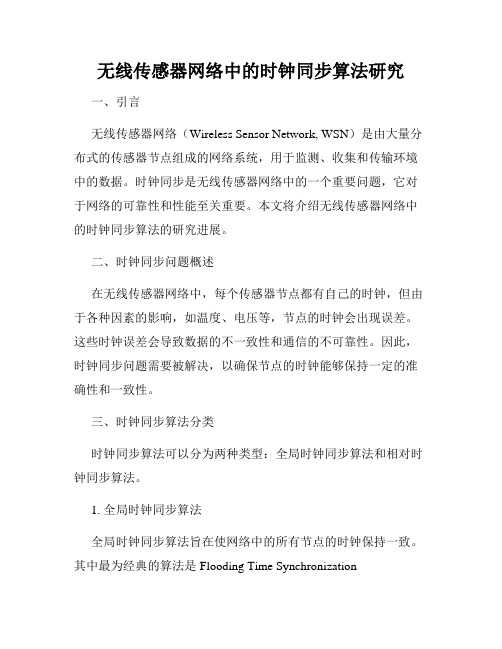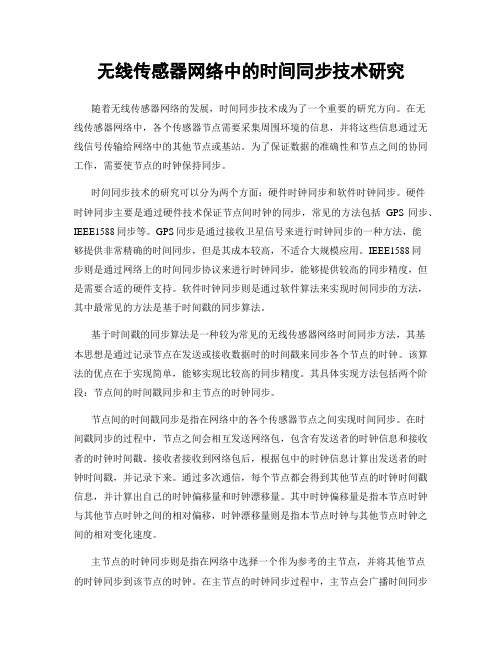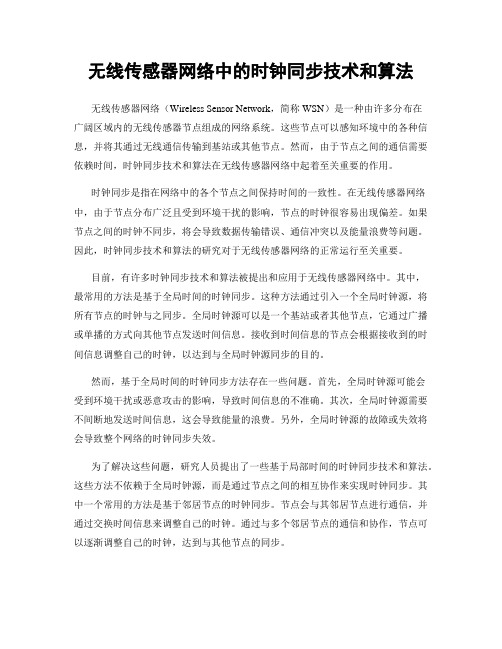无线传感器网络时钟同步技术
无线传感器网络中的时钟同步与位置定位研究

无线传感器网络中的时钟同步与位置定位研究无线传感器网络(Wireless Sensor Networks, WSN)是一种由大量分布在空间位置上的、能够采集环境信息并进行处理的无线传感器节点组成的网络系统。
这些无线传感器节点可以通过无线通信进行数据传输和协作,以实现对环境的监测、控制和感知等功能。
然而,在实际应用中,无线传感器节点的时钟不同步和位置不确定性等问题会对网络性能和应用效果产生重要影响。
时钟同步是无线传感器网络中的重要问题之一。
由于分布式部署的传感器网络中的节点通常没有全局时间信息,节点的本地时钟会出现误差。
时钟同步的目标是使得网络中的所有节点的本地时钟能够保持一致,从而协调节点之间的通信和数据处理。
在传感器网络中,时钟同步对于数据采集、事件触发、通信协议和网络协议等各个方面都具有重要的意义。
传统的时钟同步方法主要依赖于全局时间信号或者节点之间的消息交换来进行时钟校准。
然而,在无线传感器网络中,由于节点数量庞大、分布范围广泛和能量受限等因素的限制,传统的时钟同步方法存在着很大的挑战。
因此,研究者们提出了一系列的无线传感器网络时钟同步协议和算法,以解决时钟同步问题。
其中,一些基于统计模型和估计方法的算法能够通过节点之间的时间差异信息来估计节点的时钟偏差和时钟漂移,并进行校准,以实现节点之间的时钟同步。
除了时钟同步,位置定位也是无线传感器网络中的重要问题之一。
传感器节点的位置信息在许多应用场景中都具有很大的意义,比如农业环境监测、灾害预警系统和智能交通系统等。
传统的位置定位方法主要基于GPS(Global Positioning System)等全球卫星导航系统,然而,在无线传感器网络中,由于节点通常不具备GPS芯片等定位设备,因此无法直接使用GPS进行位置定位。
因此,研究者们提出了一系列的无线传感器网络位置定位算法和协议,以实现对节点位置的估计和定位。
无线传感器网络中的时钟同步和位置定位是相互关联的。
无线传感器网络中的时钟同步算法研究

无线传感器网络中的时钟同步算法研究一、引言无线传感器网络(Wireless Sensor Network, WSN)是由大量分布式的传感器节点组成的网络系统,用于监测、收集和传输环境中的数据。
时钟同步是无线传感器网络中的一个重要问题,它对于网络的可靠性和性能至关重要。
本文将介绍无线传感器网络中的时钟同步算法的研究进展。
二、时钟同步问题概述在无线传感器网络中,每个传感器节点都有自己的时钟,但由于各种因素的影响,如温度、电压等,节点的时钟会出现误差。
这些时钟误差会导致数据的不一致性和通信的不可靠性。
因此,时钟同步问题需要被解决,以确保节点的时钟能够保持一定的准确性和一致性。
三、时钟同步算法分类时钟同步算法可以分为两种类型:全局时钟同步算法和相对时钟同步算法。
1. 全局时钟同步算法全局时钟同步算法旨在使网络中的所有节点的时钟保持一致。
其中最为经典的算法是Flooding Time SynchronizationProtocol(FTSP)。
FTSP通过洪泛方式,将节点的时钟信息传递给其他节点,进而实现时钟同步。
然而,FTSP算法对网络资源的消耗较大,且易受到网络环境的影响。
2. 相对时钟同步算法相对时钟同步算法是指通过比较节点间的时钟差距,实现节点间的时钟同步。
一种常用的相对时钟同步算法是Timing-sync Protocol for Sensor Networks(TSPN)。
TSPN通过节点间的相对比较,计算出节点间的时钟差值,并以此来进行时钟同步。
相比于全局时钟同步算法,相对时钟同步算法更加灵活和适应性强。
四、时钟同步算法研究进展目前,无线传感器网络中的时钟同步算法研究已取得了一系列重要成果。
1. 时钟校准技术时钟校准技术是解决时钟同步问题的一种重要手段。
该技术主要包括外部校准和内部校准两类。
外部校准是通过与外界时间参照进行比较,对节点的时钟进行调整;内部校准是利用节点间的相对比较信息进行时钟校准。
无线传感器网络中的时间同步技术研究

无线传感器网络中的时间同步技术研究随着无线传感器网络的发展,时间同步技术成为了一个重要的研究方向。
在无线传感器网络中,各个传感器节点需要采集周围环境的信息,并将这些信息通过无线信号传输给网络中的其他节点或基站。
为了保证数据的准确性和节点之间的协同工作,需要使节点的时钟保持同步。
时间同步技术的研究可以分为两个方面:硬件时钟同步和软件时钟同步。
硬件时钟同步主要是通过硬件技术保证节点间时钟的同步,常见的方法包括GPS同步、IEEE1588同步等。
GPS同步是通过接收卫星信号来进行时钟同步的一种方法,能够提供非常精确的时间同步,但是其成本较高,不适合大规模应用。
IEEE1588同步则是通过网络上的时间同步协议来进行时钟同步,能够提供较高的同步精度,但是需要合适的硬件支持。
软件时钟同步则是通过软件算法来实现时间同步的方法,其中最常见的方法是基于时间戳的同步算法。
基于时间戳的同步算法是一种较为常见的无线传感器网络时间同步方法,其基本思想是通过记录节点在发送或接收数据时的时间戳来同步各个节点的时钟。
该算法的优点在于实现简单,能够实现比较高的同步精度。
其具体实现方法包括两个阶段:节点间的时间戳同步和主节点的时钟同步。
节点间的时间戳同步是指在网络中的各个传感器节点之间实现时间同步。
在时间戳同步的过程中,节点之间会相互发送网络包,包含有发送者的时钟信息和接收者的时钟时间戳。
接收者接收到网络包后,根据包中的时钟信息计算出发送者的时钟时间戳,并记录下来。
通过多次通信,每个节点都会得到其他节点的时钟时间戳信息,并计算出自己的时钟偏移量和时钟漂移量。
其中时钟偏移量是指本节点时钟与其他节点时钟之间的相对偏移,时钟漂移量则是指本节点时钟与其他节点时钟之间的相对变化速度。
主节点的时钟同步则是指在网络中选择一个作为参考的主节点,并将其他节点的时钟同步到该节点的时钟。
在主节点的时钟同步过程中,主节点会广播时间同步包,包含有自身时钟时间戳和计算好的时钟偏移量和时钟漂移量。
无线传感器网络中的时间同步技术研究

无线传感器网络中的时间同步技术研究无线传感器网络是由许多小型传感器节点组成的自组织网络,这些节点能够通过无线方式进行通信和数据传输。
在传感器网络中,时间同步是一个重要的研究领域。
准确的时间同步对于许多应用来说至关重要,例如事件定位、数据融合和协调传感器节点的行为。
因此,无线传感器网络中的时间同步技术的研究变得尤为重要。
无线传感器网络中的时间同步技术的目标是使网络内所有节点的时钟相互同步,以确保节点在同一时间点上进行操作和通信。
然而,由于传感器节点之间的通信受到无线信号的干扰和传播延迟等问题的影响,实现准确的时间同步是一项具有挑战性的任务。
目前,主要有两种方法用于实现无线传感器网络中的时间同步:基于硬件的方法和基于协议的方法。
首先,基于硬件的方法通过使用具有高精度时钟和呈线性增加的稳定性的震荡器来提供时间同步。
这种技术通常会增加传感器节点的成本和能耗,并且只适用于小规模传感器网络。
然而,基于硬件的方法可以提供很高的时间同步精度,并且不受网络延迟和通信干扰的影响。
另一种方法是基于协议的方法,它使用分布式算法来实现时间同步。
这些算法通常利用节点之间的通信和相对时延信息来进行同步。
一种常用的基于协议的时间同步算法是基于根节点的时间同步,其中一个节点被指定为根节点,其他节点通过与根节点的通信来同步时间。
这种方法适用于大规模传感器网络,并且可以通过调整与根节点通信的延迟来实现时间同步。
此外,一种被广泛使用的基于协议的时间同步算法是基于时隙的算法,例如时隙同步协议(Time-Slotted Synchronization Protocol)。
在时隙同步协议中,时间被划分为时隙,节点在特定的时隙内进行通信和数据传输。
通过对时隙进行调整,节点之间的时钟可以实现同步。
这种算法适用于动态网络环境,并能够在节点加入或退出网络时进行自适应。
除了上述方法,还有一些其他的时间同步技术正在被研究和开发。
例如,一些研究人员探索使用GPS(全球定位系统)来提供高精度的时间同步。
无线传感器网络时间同步

无线传感器网络时间同步无线传感器网络是由许多分布式传感器节点组成的,这些节点能够自组织通信,以收集数据和感知环境。
由于这些节点必须协作,因此它们必须具有准确的时钟以便能够对数据或事件进行同步。
无线传感器网络时间同步旨在协调网络中的每个节点以确保它们具有相同的时间参考。
它是网络内数据可靠性和完整性的基础,因为许多应用程序需要使用时间戳和顺序号来正确处理数据。
但是,在无线传感器网络中实现时间同步是具有挑战性的,因为节点的时钟精度可能受到环境条件和硬件偏差的影响。
下面是一些目前用于无线传感器网络时间同步的主要协议和技术:1. 基于发送时间戳的时间同步协议基于发送时间戳的时间同步协议是最常见的无线传感器网络时间同步协议。
在这种协议中,每个节点在发送消息时将当前时间戳附加到消息中。
接收方使用其本地时钟的当前值与时间戳比较以计算往返时延,并校准它的时钟。
该协议的优点是它的实现简单易用;缺点是由于时间戳的传输,它无法在所有情况下达到足够准确的时间同步。
2. 基于跳数的时间同步协议基于跳数的时间同步协议利用无线传感器网络中节点之间的跳数来进行时间同步。
假设网络中的所有节点都具有相同的无线电发射时间,并且在发出时间信号后,将该信号转发到所有相邻节点。
通过测量传输时间和跳数,节点可以确定其当前时间偏差,并进行时间同步。
该协议需要更高的能量消耗以维护节点之间的同步。
3. 时钟插值算法时钟插值算法是一种通用的时间同步方法,它使用数学插值来改进节点时钟的准确性。
它的基本思想是,每个节点保留它在本地的最后一次时间同步,然后通过使用两个时间同步点之间的本地振荡分组来估计其本地钟差。
这种方法需要节点能够记录更多的历史时间同步信息,并需要更复杂的算法来计算时钟偏差。
4. 时间同步协议中的校准方法为了提高时间同步协议的准确性,一些校准方法被加入其中,例如跨层反馈校准、以及基于信号速率不变性原则的校准方法。
这些校准方法可以帮助减少噪声和误差,提高时间同步协议的准确性和可靠性。
无线传感器网络中的时钟同步技术研究

无线传感器网络中的时钟同步技术研究时钟同步在无线传感器网络(Wireless Sensor Networks,WSNs)中具有重要意义。
WSNs由大量分布在监测区域内的低功耗无线传感器节点组成,这些节点通常被用于采集环境数据、感知事件并将其传输到控制中心。
在这些应用中,节点之间的时钟同步对于数据的准确采集和时间序列分析至关重要。
本文将介绍无线传感器网络中的时钟同步技术研究。
传感器网络中的时钟同步问题主要包括全局时钟同步和局部时钟同步两种。
全局时钟同步是指在整个网络中节点的时钟被调整到一致,而局部时钟同步是指在一些子区域内的节点的时钟被调整到一致。
全局时钟同步的目标是使得网络中的所有节点的时钟误差在可接受的范围内。
在WSNs中,节点的时钟通常由晶振产生,而晶振的频率不同会导致节点之间时钟的不一致。
为了实现全局时钟同步,研究者们提出了许多时钟同步算法,包括Flooding Time Synchronization Protocol (FTSP)、Reference Broadcast Synchronization (RBS)、Timing-sync Protocol for Sensor Networks (TPSN)等。
FTSP是一种基于洪泛的时钟同步协议,节点通过广播消息来同步时钟。
RBS通过引入参考节点的方式来实现时钟同步,参考节点将时间信息广播给其他节点。
TPSN是一种树型拓扑的时钟同步协议,通过树状的时间戳广播来实现节点的时钟同步。
局部时钟同步的目标是在一部分子区域内使得节点的时钟保持一致。
局部时钟同步在许多应用场景中都是非常重要的,比如在无线传感器网络中的事件检测、协同通信等。
为了解决局部时钟同步问题,研究者们提出了一些具有高效性和可扩展性的时钟同步算法,比如PairwiseBroadcast Synchronization (PBS)、Gradient-based Time Synchronization Protocol (GTSP)等。
无线传感器网络中的时钟同步技术和算法

无线传感器网络中的时钟同步技术和算法无线传感器网络(Wireless Sensor Network,简称WSN)是一种由许多分布在广阔区域内的无线传感器节点组成的网络系统。
这些节点可以感知环境中的各种信息,并将其通过无线通信传输到基站或其他节点。
然而,由于节点之间的通信需要依赖时间,时钟同步技术和算法在无线传感器网络中起着至关重要的作用。
时钟同步是指在网络中的各个节点之间保持时间的一致性。
在无线传感器网络中,由于节点分布广泛且受到环境干扰的影响,节点的时钟很容易出现偏差。
如果节点之间的时钟不同步,将会导致数据传输错误、通信冲突以及能量浪费等问题。
因此,时钟同步技术和算法的研究对于无线传感器网络的正常运行至关重要。
目前,有许多时钟同步技术和算法被提出和应用于无线传感器网络中。
其中,最常用的方法是基于全局时间的时钟同步。
这种方法通过引入一个全局时钟源,将所有节点的时钟与之同步。
全局时钟源可以是一个基站或者其他节点,它通过广播或单播的方式向其他节点发送时间信息。
接收到时间信息的节点会根据接收到的时间信息调整自己的时钟,以达到与全局时钟源同步的目的。
然而,基于全局时间的时钟同步方法存在一些问题。
首先,全局时钟源可能会受到环境干扰或恶意攻击的影响,导致时间信息的不准确。
其次,全局时钟源需要不间断地发送时间信息,这会导致能量的浪费。
另外,全局时钟源的故障或失效将会导致整个网络的时钟同步失效。
为了解决这些问题,研究人员提出了一些基于局部时间的时钟同步技术和算法。
这些方法不依赖于全局时钟源,而是通过节点之间的相互协作来实现时钟同步。
其中一个常用的方法是基于邻居节点的时钟同步。
节点会与其邻居节点进行通信,并通过交换时间信息来调整自己的时钟。
通过与多个邻居节点的通信和协作,节点可以逐渐调整自己的时钟,达到与其他节点的同步。
除了基于局部时间的时钟同步方法,还有一些其他的时钟同步技术和算法被提出。
例如,基于时间戳的时钟同步方法利用节点之间的时间戳信息来实现时钟同步。
关于无线传感器网络的时间同步技术探究

关于无线传感器网络的时间同步技术探究无线传感器网络(Wireless Sensor Networks, WSN)是由大量分布在空间中的无线传感节点组成的自组织、自适应的网络系统,它们可以感知、控制、处理和通信。
由于无线传感器网络中的节点大多是由电池供电的,节点之间的通信和定位等操作需要耗费大量的能量,因此能源是无线传感器网络中的一个关键问题。
在无线传感器网络中,为了实现网络的正常运行和协调工作,各个节点需要保持时间同步,以便协调节点之间的通信和数据处理。
时间同步技术是无线传感器网络中的重要研究方向之一,它主要解决无线传感器网络中各个节点间的时钟同步问题,以确保网络中各个节点的时间都是一致的。
时间同步技术对于无线传感器网络中的数据处理、事件协调、能源管理等方面都具有重要的意义。
在本文中,将探讨关于无线传感器网络的时间同步技术的研究现状和发展趋势,并分析其在实际应用中存在的挑战和解决方法。
无线传感器网络中的时间同步技术可以分为两大类:基于内部时钟和基于外部时钟的时间同步技术。
基于内部时钟的时间同步技术是指通过网络内部的通信和消息传递来实现节点之间的时间同步;而基于外部时钟的时间同步技术则是指通过外部时钟源(如GPS卫星)来为网络中的节点提供统一的时间基准。
具体的时间同步技术包括:全局时间同步和局部时间同步、基于时戳和基于握手等。
在无线传感器网络中,由于节点之间的通信具有不确定性和随机性,导致了节点之间的通信延迟和时钟漂移,因此要实现时间同步需要解决一系列技术难题,包括通信延迟补偿、时钟漂移校准、误差估计和误差补偿等。
目前,常见的时间同步算法有:Reference Broadcast Synchronization(RBS)、Timing-Sync Protocol for Sensor Networks(TPSN)、Flooding Time Synchronization Protocol(FTSP)等。
- 1、下载文档前请自行甄别文档内容的完整性,平台不提供额外的编辑、内容补充、找答案等附加服务。
- 2、"仅部分预览"的文档,不可在线预览部分如存在完整性等问题,可反馈申请退款(可完整预览的文档不适用该条件!)。
- 3、如文档侵犯您的权益,请联系客服反馈,我们会尽快为您处理(人工客服工作时间:9:00-18:30)。
Time Synchronization in Wireless Sensor Network System 张书钦
zsqheu@
Zhongyuan University of Technology
提 纲
一 二 三 四 概述
MAC层避免信道冲突技术 MAC层协议分类
A (node-local) software clock is usually derived as follows:
Li(t) = qi Hi(t) + fi (没有考虑计数寄存器的益处) qi is the (drift) rate, fi the phase shift 时间同步就是要修正 qi 和 fi, 而不是计数寄存器
传统同步:NTP与GPS
NTP
NTP不适合于WSN 体积、计算能力和存储空间存在限制
GPS
每颗卫星上配备有高精度的铷、铯原子钟,并不断发射其时间信息 地面接收装置同时接收4颗卫星的时间信息,采用伪距测量定位方法 可计算出时间和位置信息 缺点(室内、功耗、安全性、分布式)
速率恒定模型
该模型认为频率保持恒定不变,最常用,但不适应环境变化剧烈的场 合
飘移有界模型
常用于确定同步误差上下界,频率稳定度常用ppm(百万分之一)
飘移变化有界模型
时钟的漂移变化率是有限的。
软件时钟模型
软件虚拟时钟 一般是个分段连续、严格单调的函
时间同步的不同目的
第一种是最简单的一种,要求也最低,它只需 要保证节点之间事件发生的相对顺序,这样就 不需要节点具有相等的本地时间; 第二种时钟同步问题是保证节点之间的相对时 钟,在需要的时候,节点的本地时间可以与其 他节点的本地时间相互转换,目前大多数时钟 同步算法 , 都是针对该种同步问题; 第三种即最高要求的同步就是全网同步,全网 所有节点随时都要与网络中的一个参考时钟同 步,这就需要在网络中传播公共的时间标记。
Should backward jumps of local clocks be avoided? (Users of make say yes here ....) Avoid sudden jumps?
时间同步算法的性能和功能模块
Metrics: 性能度量
Precision: maximum synchronization error for deterministic algorithms, error mean / stddev / quantiles for stochastic ones Energy costs, e.g. # of exchanged packets, computational costs Memory requirements Fault tolerance: what happens when nodes die?
硬件时钟模型
基本名词
时间、晶振、时钟(RTC) 时钟偏移(clock offset):是指两个时钟瞬时读数的差。晶振计时的 时刻与实际时刻的差值,反映计时的准确性 Clock Skew:是指两个时钟的频率差。它可以看作是Clock offset的 一阶导数。 时间漂移(Clock Drift):是指时钟频率的变化,反映晶振的稳定性。 实际晶振的频率有可能随着外界环境温度、湿度的变化而有所改变。 Clock Drift可以看作是Clock offset的二阶导数。
不发送数据时,节点处于休眠状态,网络节点的同步休眠需 要时钟同步
测距、定位(位置相关报务,LBS)
距离测量和定位是基于无线电信号的传输时间,时间同步越 准确,距离测量也越准确
分布式系统的传统要求
分布式系统的数据库查询,状态等一致性的要求
协作传输、处理的要求
协作传输是基于电磁波的能量累加效应,多个节点以相同的 调制解调方式同时发送信号,使得远处的汇集节点能接收到 信号
同步协议需要解决的问题
同步精度 功耗 可扩展性
时间同步技术的分类
排序、相对同步与绝对同步
递进关系
• • • • 排序只能区分事件发生的先后 相对同步:维持本地时钟的运行,定期获取其他节点的时钟偏 移和飘移,经过换算达到同步的目的。如RBS协议 绝对同步:本地时钟和参考时钟保持一致,修改本地时钟。如 TPSN协议
基于多信道的MAC层技术
时间同步
由于物理上的分散性,网络无法为彼此间相互独立的节点提供一 个统一的全局时钟,每个节点各自维护它们的本地时钟。 由于这些本地时钟的计时速率、运行环境存在不一致性,因此即 使所有的本地时钟在某一时刻都被校准,一段时间后,这些本地 时钟间也会出现失步。为了让这些本地时钟再次达到相同的时间 值,必须进行时间同步操作。 时间同步就是通过对本地时钟的某些操作,达到为分布式系统提 供一个统一时间标度的过程。 传感器网络自身协议的运行及基于其上的应用,如标记数据采集 时间、时分多址接入、协同休眠、定位、数据融合等都需要网络 中节点的时钟保持同步。 时间同步算法设计必须考虑到两方面的因素:
Deviations are specified in ppm (pulses per million), the ppm value counts the additional pulses or lost pulses over the time of one million pulses at nominal rate The cheaper the oscillators, the larger the average deviation
A-priori vs. a-posteriori synchronization
Is time synchronization achieved before or after an interesting event?
Post-facto synchronizs. stochastic precision bounds Local clock update discipline
Fundamental building blocks of time synchronization algorithms:
Resynchronization event detection block: when to trigger a time synchronization round? Periodically? After external event? Remote clock estimation block: figuring out the other nodes clocks with the help of exchanging packets Clock correction block: compute adjustments for own local clock based on estimated clocks of other nodes Synchronization mesh setup block: figure out which node synchronizes with which other nodes
外同步与内同步
参考源不同,前者参考源为网络外部,如GPS。后 者参考源为网络内部某个节点的时钟
局部同步与全网同步
同步对象的范围不同
时间同步技术的应用场合
多传感器数据压缩与融合
邻近传感节点对相同事件的感知数据需要融合,基于时间戳 判断是否同一事件,需要时钟同步
低功耗MAC协议、路由协议
节点上的时钟
hardware clock
振荡器以固定频率产生脉冲 每隔一定脉冲后计数寄存器增加1
• Only register content is available to software • Register change rate gives achievable time resolution
时间同步算法
Physical time vs. logical time External vs. internal synchronization Global vs. local algorithms
Keep all nodes of a WSN synchronized or only a local neighbourhood?
1) 减少时间同步自身带来的能量消耗; 2)提供较高时间同步精度以有效减少其它关键技术带来的能量消耗。
WSN时间同步技术背景
集中式系统与分布式系统
集中式:事件间有着明确的时间先后关系,不存在 同步问题 分布式:同步是必需的,只是对同步的要求程度不 同
无线传感器网络时间同步
典型的分布式系统 是无线传感器网络应用的基础
Absolute vs. relative time Hardware vs. software-based mechanisms
A GPS receiver would be a hardware solution, but often too heavyweight/costly/energy-consuming in WSN nodes, and in addition a lineof-sight to at least four satellites is required
Node i’s register value at real time t is Hi(t)
• Convention: small letters (like t, t’) denote real physical times, capital letters denote timestamps or anything else visible to nodes
